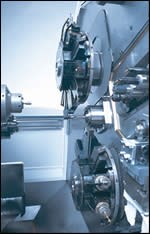Swiss-Type Turning Without A Guide Bushing
The traditional CNC Swiss-type machine is well suited to parts that are long and slender. Here is an alternative for other types of turned parts.
Share


ECi Software Solutions, Inc.
Featured Content
View More.png;maxWidth=45)
DMG MORI - Cincinnati
Featured Content
View More

Takumi USA
Featured Content
View More

Among the smaller-diameter parts that are typically produced through bar-fed turning, what kinds of parts call for Swiss-type turning using a guide bushing?
Klaus Voos, senior vice president of the Index Corporation (Noblesville, Indiana), says that this type of turning is used too often. "Our feeling is, the guide bushing is something you use only if you have to," he says.
Index offers machines that both do and do not have the bushing. Its Traub TNL series of lathes provides a common platform that is available both as a conventional Swiss-type machine and as a machine that supports the work only using a collet.
The guide bushing lets the machine feed the work out through the headstock during cutting. This makes the machine effective for the turning of parts that are relatively long and slender. The tool can remain close to the workpiece's point of support throughout the length of a long part, dramatically reducing the risk of deflection.
However, many shops tend to equate these machines with high-volume turning in general, using them for a variety of bar-fed parts. This can be a mistake, says Mr. Voos. When the part is not particularly long relative to its diameter, eliminating the guide bushing can offer various advantages. They include:
- Securing the work more rigidly. Without the bushing, the collet is closer to the work. More rigid clamping lets the machine take deeper cuts, achieve better finishes and take on more demanding materials.
- Reduced setup time. Changing jobs on a conventional Swiss-type machine can involve the time necessary to adjust the bushing to size. Without the bushing, loading the same new job may be as easy as just closing the collet down on the work.
- Material cost savings. There are multiple reasons for the material cost savings. One relates to the remnant. A machine with a guide bushing generally must leave about 6 inches of barstock behind. In addition, unlike the bushing-equipped machine, the lathe without a bushing may not require precision barstock of such high dimensional quality.
The Traub TNL machines offer some simplicity to shops that want access to both types of turning. The versions of these machines without the guide bushing still leave the tool turrets, the tool posts and the configurations of front work and back work axes all unchanged. Because the machines are fundamentally the same beyond the headstock, tooling and accessories can be used interchangeably between the two types. Programming and operation are the same, as well.















.png;maxWidth=150)
























.jpg;maxWidth=300;quality=90)

